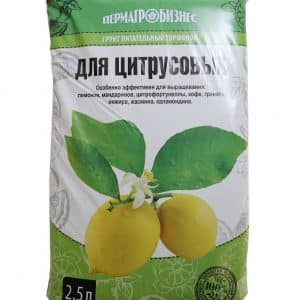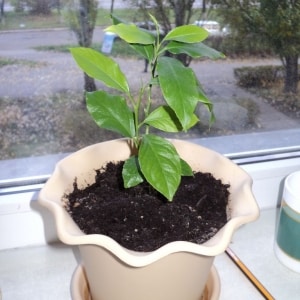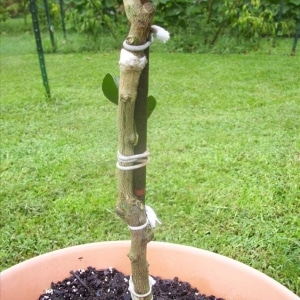How to plant a lemon - step by step instructions
Lemon is an evergreen tree with fleshy, dark green leaves that exude a characteristic citrus aroma. The plant looks attractive all year round. It looks especially interesting during the flowering and fruiting period.
The advantage of citrus fruits is that they are easily propagated not only by layering and cuttings, but also by seeds. Contrary to the opinion of many novice gardeners, a lemon, even grown generatively (that is, from a seed), is quite capable of blooming and bearing fruit. How to plant a lemon from a seed at home with your own hands and achieve its proper development, read on.
Is it possible to plant a lemon from a seed at home?
You can grow a lemon tree from a seed at home. In this case, you will be able to get a beautiful green plant next year. It will develop quickly and have a beautiful shape. The main advantage of this method is that plants propagated by the generative method are stronger, hardier and more viable than lemons obtained from cuttings.
With this method of propagation, citrus trees will definitely bear fruit. However, this will not happen earlier than 5-8 years after planting. With the vegetative method of propagation, fruits appear on lemons already in the 4th year.
Another disadvantage of the generative method is that seeds obtained from fruits purchased in the supermarket produce wild fruit. It produces smaller and more acidic fruits.But they are formed in large quantities.
Note! There is still a chance that a lemon tree grown by seed will retain its varietal characteristics.
All of these deficiencies can be easily corrected by grafting. If you attach a varietal scion to a wild rootstock, the resulting plant will combine all the advantages of generative and vegetative propagation. The tree begins to bear fruit early, acquires varietal characteristics, and becomes strong and hardy.
Rules for planting lemons
Lemon cultivation begins with planting. This stage requires maximum attention. After all, whether the planting material will germinate, whether the seedlings will take root and whether the plant will bear fruit depends on the correct implementation of this process.
Selecting a variety and seeds
You can grow absolutely any lemon at home. However, it is recommended to give preference to low-growing varieties. These include:
- Pavlovsky. An old variety that is distinguished by its ability to grow with a lack of light and moisture.
- Mayer. A mixture of lemon and orange. It has orange aromatic fruits without bitterness. Sweeter than other lemons.
- Chinese. The first harvest is produced already 2-3 years after planting. The fruits ripen quickly. It has high productivity.
- Anniversary. Blooms and bears fruit profusely. Sour fruits with thick skin reach a weight of 0.5 kg. Capable of mating in any conditions.
- Genoa. It blooms and bears fruit 2-3 times a year. It has small fruits weighing up to 150 g. It has high taste characteristics.

When grown by seed, it will not be possible to choose a variety. But the desired option can be easily grafted onto a rootstock obtained by generative methods.
To grow lemon at home, it is important to choose suitable planting material.The fruits from which it will be obtained must have the most correct shape and uniform yellow color. It is important that they are elastic, ripe, without signs of damage diseases and pests.
The seeds are removed from the selected fruits and prepared for planting:
- Selecting suitable seeds. For planting, select large, dense seeds with a uniform light color without any damage. Thin and soft bones, specimens with spots, holes, and signs of disease and pest damage are not suitable.
- Disinfection. For 30 min. The seeds are soaked in a light pink solution of potassium permanganate, hydrogen peroxide or Fitosporin.
- Growth stimulation. For this purpose, purchased nutritional compositions “Epin”, “Solution”, “Heteroauxin” are used. Self-prepared mixtures are also suitable, for example a solution of ash or aloe juice.
Prepared seeds are used without preliminary drying. They cannot be stored for a long time. It is recommended to take several times more planting material than is actually required. This is due to the fact that not all seeds will germinate, and from the resulting sprouts you will have to choose the strongest ones. A few specimens will help you experiment with growing grafted and ungrafted lemons.
Advice! Some citrus growers remove the hard shell so that the seeds germinate faster. In this case, it is important not to damage the cotyledons.
Preparing the pot and soil
Soil for lemon is also important. It should be light, nutritious, slightly acidic. The easiest option is to purchase ready-made soil for citrus fruits. It is more profitable to prepare the soil for growing lemons yourself. To do this, mix humus, sand, peat and leaf soil in equal proportions.

Note! High red peat has high acidity and is not suitable for growing lemons. To prepare the soil, choose lowland black peat.
Regardless of whether the soil is purchased or homemade, it is disinfected before use. To do this, pour boiling water over it, calcinate it in the oven, or pour over it with a dark pink solution of potassium permanganate.
The seeds are sown in one common container. They are planted when two true leaves appear on the seedlings in a container with a volume of 200-300 ml. Pots are also disinfected with a solution of potassium permanganate or boiling water.
You will also need disinfected drainage, for example, shards, broken ceramics, small crushed stone.
Step by step planting lemon
How to plant lemon:
- A layer of drainage 1-2 cm thick is poured onto the bottom of the container. Then the fertile mixture is poured so that 2-3 cm is left free to the edge of the pot.
- The seeds are sown to a depth of 1-1.5 cm. They are sprinkled with soil, which is slightly compacted.
- The soil is moistened with warm water with the addition of a growth stimulator from a spray bottle.
- The top of the container is covered with glass or film. Then put in a warm place.
Rules for caring for homemade lemon
Proper care of a lemon in a pot is a guarantee of full development, flowering and fruiting of the plant. Any errors in cultivation cause yellowing and falling leaves, and the death of the lemon. Therefore, it is important to follow the basic rules and take into account the nuances.
Seedling care
For seedlings to germinate, it is not enough to plant them correctly. It is important to provide the necessary conditions and care:
- The greenhouse is regularly ventilated. To do this, it is removed daily for 15-30 minutes. There should be no drafts in the room during ventilation.
- The soil is moistened as it dries. This is done using a spray bottle so as not to wash away the soil and expose the seeds.For irrigation use warm, settled water.
- The box with seedlings should be at a temperature of +24…+26°C. Such indicators will allow the seeds to germinate faster.
When the first shoots appear, the duration of ventilation is increased. After 7-14 days, the film is completely removed.
While the plants are in a common box, they are watered with warm water from a spray bottle. When two true leaves appear, they are planted in individual containers.
The best seedlings are chosen for picking:
- preference is given to specimens with short internodes (short distance between buds);
- the denser the bark, the better;
- the plant should have good turgor and a bright green color;
- leaves - firmly adhere to the shoots (the more there are, the better).
A layer of drainage and soil are poured onto the bottom of the transplant container. The seedling is placed in a pot and covered with soil without deepening the root collar. After transplanting, water the lemon.
Lemon tree care
Caring for a grown lemon tree is not difficult. The main thing is to follow the basic rules:
- Temperature. Should vary between 19-27°C. Optimal values are considered to be 20-22°C. In winter, it is advisable to move the plant to a room with a temperature of 8-12°C.

- Watering. In the hot season, water the lemon daily with a small amount of warm, settled (preferably melt or rain) water. This is done in the morning or evening. After each watering, the soil is loosened. By the end of autumn and throughout the winter, the frequency of watering is reduced to 1-2 times a week.
- Humidity. Tropical lemon requires high humidity. To ensure optimal conditions, it is sprayed daily with warm water. If the citrus is dormant in winter, then spraying is not carried out during this period.If the plant is in a heated room, then place a humidifier and containers of water nearby.
- Lighting. A pot of citrus is placed on a southern or western windowsill. During the daytime it is shaded with a translucent curtain. From late autumn to early spring, it is advisable to install additional lighting. If the lemon is dormant during the cold season, then this is not necessary.
- Formation. Particular attention is paid to the formation of the lemon. This determines whether the plant will bear fruit. The central shoot is pinched when it reaches a height of 20-30 cm. Side shoots of the 1st-3rd order are pinched at a level of 15-20 cm. At the same time, 3 to 5 branches are left at each level. Stems of the 4th-6th order are not touched, since it is on them that fruits and inflorescences are formed.
- the washing up. Wipe the lemon leaves weekly with a damp cloth. Every month the plant is washed in the shower.
- Feeding. Fertilizing is applied once every 1-2 weeks. Before this, the lemon must be watered. Alternate mineral and organic fertilizers. The procedure is carried out in the evening.
Stores sell ready-made complex mineral compositions for citrus fruits, which include all the necessary elements.
Chicken manure diluted in water in a ratio of 1:20 and rotted manure with water in a ratio of 1:10 are used as organic fertilizer.
Folk remedies are also used:
- Infusion of vegetable peelings. They fill the container up to half. The rest of the volume is filled with water. The product is infused for 3 days. Then the liquid is filtered and diluted with water in a ratio of 1:3.
- Tea and coffee. Tea and coffee brews are buried in the ground. The remains of unfinished drinks are poured into the pot.
- Nettle decoction. 1 tbsp. l. nettles brew 1 tbsp. water.The product is infused for 4 hours, then used for watering.
Graft
Wild lemon is grafted to produce varietal fruits and speed up fruiting. The procedure is carried out in early spring or late autumn.
It is recommended to vaccinate a wild bird when it reaches one year of age. It's best to do it in a split. For this:
- A cutting with 2-3 buds is cut from a one-year-old branch of a varietal lemon that has already bear fruit. It must be healthy, without signs of damage and diseases.
- The wildflower is cut so that only the trunk remains without leaves and shoots. A split is made in the center.
- Leaves are torn off the scion. The cut area is ground down to form a thin peg. The depth of the split should match the length of the wedge.
- The scion wedge is inserted into the split of the rootstock so that they fit as tightly as possible to each other.
- The junction is wrapped with electrical tape, leaving no open areas.
- Wet cotton wool is placed around the rootstock. A bag is placed on top and secured to the pot.
- The bag is removed daily for 10-15 minutes. and spray the lemon with warm water. The cotton wool is moistened as it dries.
The awakened buds indicate that the scion has taken root. After this, the duration of ventilation is increased, gradually removing the greenhouse. Then remove the electrical tape.
How and when to replant a lemon
When it’s time to replant a lemon grown from a seed is determined based on its age:
- Up to 5 years, the plant is transshipped annually. To do this, it is taken out of the pot along with a lump of earth. Only the drainage and top layer of soil are removed. The plant is moved to a new pot filled with drainage. The missing soil is simply added.
- After 5 years, transplantation is performed every 3 years. The plant is being replanted. It is taken out of the pot and at least 2/3 of the soil is removed.Remove all dry and rotten roots. The plant is planted in a pot filled with soil and drainage.
- When the lemon reaches the desired size, replanting is stopped. Every year, 3 cm of top soil is removed and replaced with new soil.
After transplantation, the plant is watered. It is placed in a shaded place for 2 weeks. Feeding resume in a month.
Conclusion
Grow a lemon from a seed is easy. Citrus seeds germinate quickly and take root well. It is only important to plant the planting material correctly and select the strongest specimens from the resulting seedlings.
Whether a lemon obtained from a seed will bear fruit depends on its care. Even without grafting, the plant will bloom in the right conditions in 5-8 years, and with grafting this will happen 2 years faster.